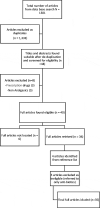Knowledge, use (misuse) and perceptions of over-the-counter analgesics in sub-Saharan Africa: a scoping review
- PMID: 34420494
- PMCID: PMC8386732
- DOI: 10.1080/16549716.2021.1955476
Knowledge, use (misuse) and perceptions of over-the-counter analgesics in sub-Saharan Africa: a scoping review
Abstract
Background: Over-the-counter (OTC) analgesics are safe for pain-management when used as recommended. Misuse can increase the risk of hypertension and gastrointestinal problems.
Objective: To conduct a scoping review of the uses and misuses of OTC analgesics in sub-Saharan Africa, to inform strategies for correct use.
Method: Following guidelines for conducting a scoping review, we systematically searched Pubmed, ResearchGate and Google Scholar databases for published articles on OTC analgesic drug use in sub-Saharan Africa, without restrictions on publication year or language. Search terms were 'analgesics', 'non-prescription drugs', 'use or dependence or patterns or misuse or abuse' and 'sub-Saharan Africa'. Articles focusing on prescription drugs were excluded.
Results: Of 1381 articles identified, 35 papers from 13 countries were eligible for inclusion. Most were quantitative cross-sectional studies, two were mixed-methods studies, and one used qualitative methods only. About half (n = 17) the studies recorded prevalence of OTC drug use above 70%, including non-analgesics. Headache and fever were the most common ailments for which OTC drugs were taken. Primary sources of OTC drugs were pharmacy and drug shops, and family, friends and relatives as well as leftover drugs from previous treatment. The main reasons for OTC drug use were challenges in health service access, perception of illness as minor, and knowledge gained from treating a previous illness. Information regarding self-medication came from family, friends and neighbours, pharmacies and reading leaflets either distributed in the community or at institutions of learning. OTC drug use tended to be more commonly reported among females, those with an education lower than secondary level, and participants aged ≥50 years.
Conclusion: Self-medicating with OTC drugs including analgesics is prevalent in sub-Saharan Africa. However, literature on reasons for this, and misuse, is limited. Research is needed to educate providers and the public on safe use of OTC drugs.
Keywords: Over the counter; Sub-Saharan Africa; analgesics; non-prescription drugs; self-care; self-medication.
Conflict of interest statement
No potential conflict of interest was reported by the author(s).
References
-
- Wilinski J, Lechowicz M, Kameczura T, et al. Non-steroidal anti-inflammatory drugs and paracetamol in self-therapy of various disorders in students of different fields of study. Folia Med Cracov. 2015;5549–14. Epub 2016/ 02/04. PubMed PMID: 26839243. - PubMed
-
- Stosic R, Dunagan F, Palmer H, et al. Responsible self-medication: perceived risks and benefits of over-the-counter analgesic use. Int J Pharm Pract. 2011;19:236–245. Epub 2011/ 07/08. PubMed PMID: 21733011. - PubMed
Publication types
MeSH terms
Substances
Grants and funding
LinkOut - more resources
Full Text Sources
Medical

